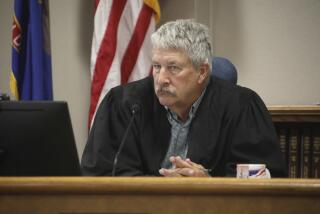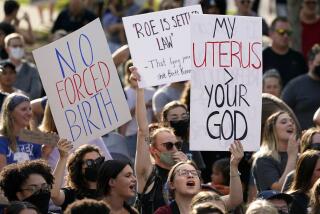High Court Strikes Down ‘Partial-Birth’ Abortion Ban
WASHINGTON — The Supreme Court, ending its term on a bitter note, struck down on a 5-4 vote Wednesday a state ban on so-called partial-birth abortions.
The majority said that the Nebraska law was unconstitutional because it failed to protect “the health of the mother.” Thirty other states have similar laws that also are likely to fall as a result of Wednesday’s decision.
But the four dissenting justices called the ruling an outrage and predicted that it will set off a firestorm of public reaction.
If nothing else, the outcome made clear that the justices remain at war over abortion and that the future of abortion rights likely depends on who wins the fall presidential election.
The two major party contenders are as divided on the abortion issue as are the justices. The Republican, Texas Gov. George W. Bush, voiced dismay over the ruling and pledged to reverse the result if elected. Taking the opposite view, Vice President Al Gore praised the majority for protecting “a woman’s right to choose.”
Since 1973, abortion has been legal in the nation and more than 90% of abortions take place during the first months of pregnancy.
The dispute over “partial-birth abortion” tested whether states could regulate how doctors perform midterm abortions. After 16 weeks’ gestation, a fetus is too large to be removed through a suction tube, the most common method of abortion.
One midterm abortion procedure involves dismemberment of the fetus while it is still in the womb.
Under the banned procedure, the physician cuts the umbilical cord and then removes the tiny fetus intact rather than in parts. Because its heart may be beating at the time of the removal, abortion foes have said that the doctor is killing a live baby.
However, the court majority pointed out that the fetus is killed in either procedure. Citing testimony from medical experts, it said that an intact removal is often safer for the mother because it reduces bleeding and avoids injury to her uterus.
The state may “not endanger a woman’s health when it regulates the methods of abortion,” said Justice Stephen G. Breyer, speaking for the court.
O’Connor Opens Way to Other Options
Doctors refer to the banned procedure as an intact removal, or a D&X.; The American College of Obstetricians and Gynecologists said that the D&X; procedure “may be the best or most appropriate procedure in a particular circumstance to save the life or preserve the health of a woman,” Breyer noted.
A law barring doctors from using this abortion method “creates a significant health risk” and therefore violates the woman’s constitutional rights, he said.
Further, the majority found that the Nebraska law is flawed because its wording would also appear to ban the conventional dismemberment procedure, called a D&E; by doctors.
Justices John Paul Stevens, Sandra Day O’Connor, David H. Souter and Ruth Bader Ginsburg joined Breyer’s opinion.
In a concurring opinion, O’Connor left open the possibility that states could write a new ban. But to be ruled constitutional, it would have to make exceptions to protect the health of the mother, she said.
The dissenting justices, focusing on how the fetus dies, called the intact removal procedure “horrifying” and “repulsive.” They said that the state should have the power to express its moral repugnance for abortion by making this procedure a crime.
The dissenters included Justice Anthony M. Kennedy, who voted to uphold the basic right to abortion in 1992. The disputed procedure is “abhorrent” and should be outlawed, he said.
In another dissent, Justice Antonin Scalia called the procedure “so horrible that the most clinical description evokes a shudder of revulsion.” The right to abortion must be overruled, he said.
Justice Clarence Thomas filed a 44-page dissent, joined by Chief Justice William H. Rehnquist, which called the Nebraska ruling “indefensible.”
Both presidential candidates took time out from campaigning to comment on the ruling.
“I can’t tell you how disappointed I am” with the Supreme Court ruling, Bush, who opposes abortion and has cited Scalia and Thomas as model justices, said in Cleveland on Wednesday. “The states should have the right to enact reasonable laws, particularly when [those laws would ban] taking a life that otherwise would live,” he said.
(In fact, the Nebraska law did not save any lives but simply required doctors who perform second-term abortions to use the more conventional “dismemberment” method.)
Gore, who strongly supports the right to abortion and has said that he would appoint only justices who share his view, praised the court’s majority for upholding “a woman’s right to choose.” He avoided mention of the Nebraska law or “partial-birth abortion.”
Gore Sees Marshall, Brennan as Models
“The presidential election will decide the future of the Supreme Court,” said Gore, who also was campaigning in Ohio. “My models [for a future nominee] would be Justices Thurgood Marshall and William Brennan,” the legendary liberals who championed civil rights and the right to abortion during the 1970s and 1980s.
None of the justices has spoken of retirement but several might step down during the next four years. Rehnquist, the conservative leader, will be 76 in October. Justice John Paul Stevens, the senior liberal, is 80. And O’Connor, who cast the deciding vote to strike down the Nebraska law, turned 70 in March.
Over the last five years, “partial-birth” abortion has taken center stage in the abortion wars. The Republican-led Congress has twice passed measures to make the procedure a federal crime but all were vetoed by President Clinton. Anti-abortion leaders then turned to the states, where many legislatures quickly passed laws that adopted the language of the National Right to Life Committee.
The Nebraska Legislature passed its law in 1997 by a 99-1 vote. Dr. Leroy Carhart, a former Air Force surgeon, is the only physician who performs second-term abortions in Nebraska. His clinic near Omaha also draws patients from five surrounding states.
Carhart contended that the state law, if it had gone into effect, would have forced him to use a riskier procedure with some of his patients. A federal judge in Lincoln, Neb., conducted a trial on the issue and ruled that the state law was unconstitutional. Nebraska Atty. Gen. Don Stenberg, a Republican who now is running for the U.S. Senate, appealed the case to the U.S. 8th Circuit Court of Appeals in St. Louis. The appeals court agreed with the lower court, leading to the Supreme Court showdown in the case (Stenberg vs. Carhart, 99-830).
Despite the importance of the case to the abortion debate, Wednesday’s decision will not affect most abortions. Of the roughly 1.2 million abortions performed in the United States each year, more than 90% occur in the first months of a pregnancy. At that stage, the soft fetus is small enough to fit inside a golf ball and is removed through a suction tube.
Nonetheless, reactions to Wednesday’s decision were strong.
House Republican Conference Chairman J. C. Watts Jr. of Oklahoma said that a Republican in the White House would end the “gruesome procedure known as partial-birth abortion. A nation that condones stabbing a baby in the head with scissors [and] sucking the child’s brains out . . . is in serious trouble.”
The National Conference of Catholic Bishops said that abortion supporters had “crossed the line from abortion to infanticide.”
On the other side of the issue, women’s rights groups said laws such as Nebraska’s show that anti-abortion advocates are willing to sacrifice a woman’s life and health.
The Center for Reproductive Law and Policy in New York, which represented Carhart, said that the lawsuit “exposed these bans for what they are: extreme and deceptive attempts to outlaw abortion.”
Protesters Targeted in Related Decision
In a second abortion-related decision Wednesday, the court said that anti-abortion protesters may be kept eight feet away from women and doctors entering abortion clinics.
The 6-3 ruling upheld a Colorado law that regulates protesters who come within 100 feet of a medical facility.
The majority said that the law shields the “unwilling listener” from being confronted face-to-face by protesters. The three dissenters--Scalia, Kennedy and Thomas--called the ruling a serious violation of the 1st Amendment.
The ruling (Hill vs. Colorado, 99-1856) appears to clear the way for similar ordinances that have been enacted by several cities in California.
*
Times staff writers Richard T. Cooper and Bonnie Harris contributed to this story.
*
* SHIFT IN MOMENTUM?
Abortion foes may be disappointed, but ruling may give their side the edge. A12
More to Read
Get the L.A. Times Politics newsletter
Deeply reported insights into legislation, politics and policy from Sacramento, Washington and beyond. In your inbox three times per week.
You may occasionally receive promotional content from the Los Angeles Times.











